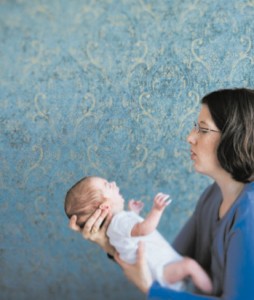March 29th, 2011 by Bryan Vartabedian, M.D. in Opinion
No Comments »

I frequently talk about the visibility of doctors in the online space. How can doctors make content, contribute to the broader dialog, and be more visible? Maybe I need to spend less time pushing the idea that every doctor needs to create. Most doctors, after all, just want to listen and watch. Maybe we need to be cultivating dedicated communicators.
There’s a role evolving where physicians are formally involved in the creation of content and the maintenance of dialog. Wendy Swanson at Seattle Children’s Hospital and Claire McCarthy at Boston Children’s Hospital come to mind as good examples. Both serve as models for how institutions can leverage the voice of an individual for a branded online identity while contributing to the common good. Both are evolving as conversation agents on social platforms and IRL. Call them medical conversation agents of new media. Read more »
*This blog post was originally published at 33 Charts*
March 19th, 2011 by DrWes in Opinion, True Stories
No Comments »

Every day, doctors do risky things for their patients, often because they have no other options. Today is such a day for me.
I don’t know how it will go, and because of privacy laws I really can’t tell you about the case, I’m sorry. (Nor will you get an epilogue, that’s not the point of this post). But let’s just say that any normal person would consider the case I’m about to perform very high risk because of the patient’s condition. Even though you tell people they could die and take care to mention that fact time and time again, you wonder if they really can comprehend the significance of what you’re saying – after all, there is a fine line between being reassuring in a time of crisis and telling it like it is. Read more »
*This blog post was originally published at Dr. Wes*
March 19th, 2011 by Bryan Vartabedian, M.D. in True Stories
No Comments »

 This week I lost one of my patients, Cooper. He was a feisty 4-year-old with mitochondrial depletion syndrome. I began looking after him as an infant when he wouldn’t stop screaming. I saw him through surgeries, diagnostic rabbit trails, and ultimately helped with the painful decision to undergo small bowel transplantation. Inexplicable symptoms and strange complications defined his short life. While he spent his final days in considerable pain, his lucid moments were spent throwing marshmallows at his siblings. It sort of encapsulates who he was. Great spirit.
This week I lost one of my patients, Cooper. He was a feisty 4-year-old with mitochondrial depletion syndrome. I began looking after him as an infant when he wouldn’t stop screaming. I saw him through surgeries, diagnostic rabbit trails, and ultimately helped with the painful decision to undergo small bowel transplantation. Inexplicable symptoms and strange complications defined his short life. While he spent his final days in considerable pain, his lucid moments were spent throwing marshmallows at his siblings. It sort of encapsulates who he was. Great spirit.
Independent of the circumstances, a child’s death is always brutally difficult to process. It’s counterintuitive. And facing Cooper’s parents for the first time after his passing was strangely difficult for me. When he was alive I always had a plan. Every sign, symptom, and problem had a systematic approach. But when faced with the most inconceivable process, I found myself awkwardly at odds with how to handle the dialog. In a hospital my calculated clinical role has a way of sheltering me from a parent’s reality. At a funeral it’s different. Read more »
*This blog post was originally published at 33 Charts*
December 24th, 2010 by Bryan Vartabedian, M.D. in Better Health Network, Opinion
No Comments »


Jenni Prokopy (aka Chronicbabe) put us to the challenge for this week’s Grand Rounds by asking for our 2011 clinical resolutions. I have to admit that I’m not one for resolutions because I can never take them seriously. But admittedly there are things that I need to tighten up. So here goes:
1. Clear my chart rack every afternoon. This is key because my creative mind operates better when my charts are done. Of course this means no more tweeting “47 charts” or “33 charts” when I’m behind. Had I made this resolution for 2009, this blog wouldn’t have a name.
2. Cultivate innovative communication channels with my referring docs. While I need to be consistent and compulsive with my referral letters, I want to improve mobile, real-time communications between me and my referring docs. For example I’d like to get my local community on Doximity so that I can launch a quick, HIPAA compliant, encrypted SMS messages on my iPhone the second I see a patient. Read more »
*This blog post was originally published at 33 Charts*
December 3rd, 2010 by Bryan Vartabedian, M.D. in Better Health Network, Opinion, True Stories
No Comments »

I just can’t imagine life today as a medical student. Every medical publication in the palm of your hand. The capacity to create an audience and publish at your own will. Real-time dialog between students, faculty, anyone. Global reach from your phone. It’s mind-boggling really.
This is in stark contrast to my experience. My world was centered on index cards, textbooks and pens with different colors. We communicated via Post-it notes on the door of the student lounge. There were no apps and our only game was foozball. As a first year I scheduled time to compose H&Ps on the library’s only Macintosh II computer. This was plugged into the new Apple LaserWriter with WYSIWYG. Hi tech we were. We thought.
Being distractible and restless, I’m going to guess that if I had access to the communication platforms and tools available to today’s students, I might not have made it through. The inputs must be staggering and I imagine that discipline with personal bandwidth has become a critical key to survival. Read more »
*This blog post was originally published at 33 Charts*














